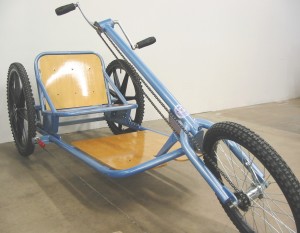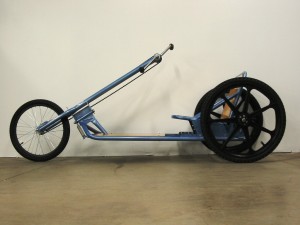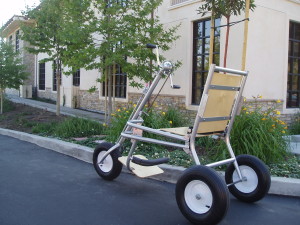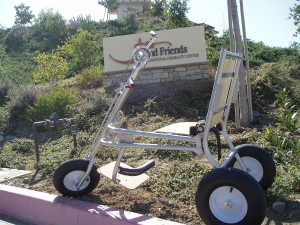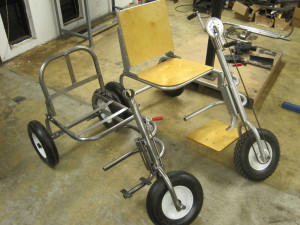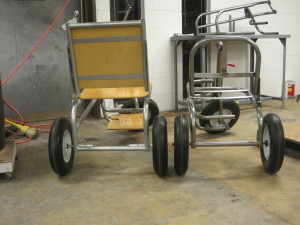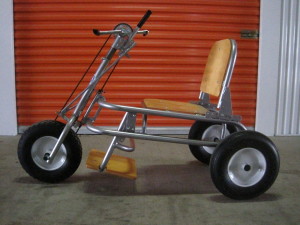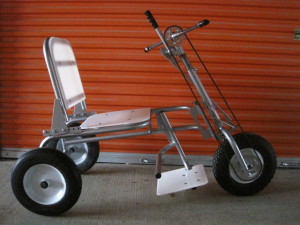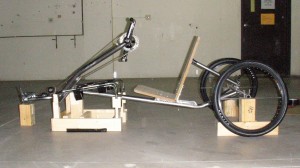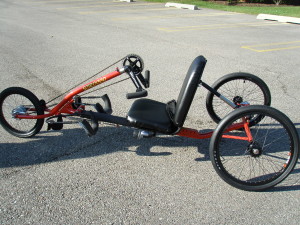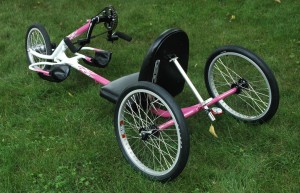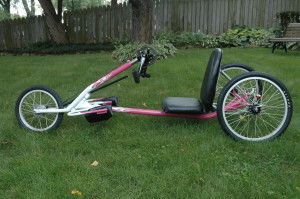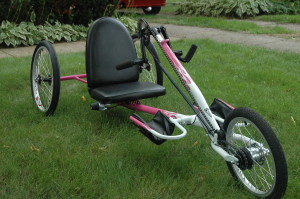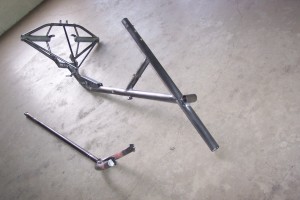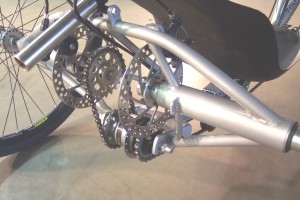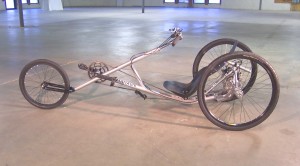HAND PEDALED TRIKE HISTORY
His Wheels International began in 2005. Below are the major milestones in the evolution of our hand-pedaled three-wheeled cycle design which we affectionately call a trike.
We incorporated in May, 2005 with the idea of getting two-wheeled bicycles to developing countries. By July we learned of the need for trikes throughout Africa. By late October, after meeting Kevin, our new design engineer , our first prototype had been rolled out.
———————————————————————-
2005
THE FIRST GENERATION
Our first generation hand pedaled trike was one we called the “low rider” (see pictures). Long and low, it sat only inches off the ground and was specifically designed to make entry as easy as possible. Bike wheels were used (Skyway composites in the rear) as well as a direct drive system based upon the old Schwinn style single piece crank.
The problem that we soon discovered was that a trike so low cannot be easily seen in an urban street traffic situation (yes, Africa has these), creating a safety issue. Only one was made. However, several future projects, including the Scirroco racing trike would someday trace their lineage back to this basic layout and experiments with this early prototype.
———————————————————————-
Our second generation trike reverted to an upright seat position for better visibility. It was built without the use of tube bending equipment to experiment with a simplified construction method.
We had also been asked to design a version using wheelbarrow wheels and cargo space, as well as make it easy to disassemble and ship overseas. This basic design was built in several different variations, including one with conventional 16″ bike wheels.
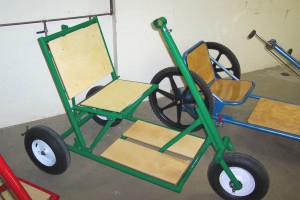
Some were sent overseas for testing.
While this generation was an important step forward in many ways, there were still issues with leg clearance, general ergonomic issues, a need for improved gearing, too many sharp corners, etc.
———————————————————————-
As we searched for an easier way to “connect the dots” of a new trike frame design, we began to conceive of a way to clear the usual frame obstructions out of the way of the user’s feet. We also wanted a much simpler way to attach the seat back directly to the trike frame. We also wanted to attach the rear axles directly to these same frame members so as to eliminate additional tubing, weight and simplify construction.
Two initial prototypes using this somewhat unconventional layout were made in 2007. One went with Alice to Joni And Friends in California and the other ended up in Bulgaria.
Note: We now call these two early prototypes (without an adjustable seat back) the DOTT “A” version. While the basic frame design was clearly a step in the right direction, the follow-on DOTT-B design would have enough changes to require a new designation, thus the “B”.
———————————————————————-
2008
THE THIRD GENERATION GOES INTO LIMITED PRODUCTION.THE DOTT-B.
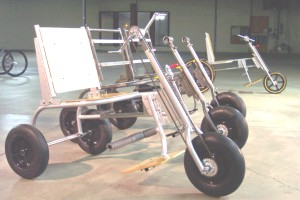
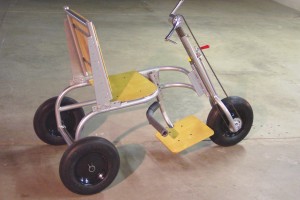
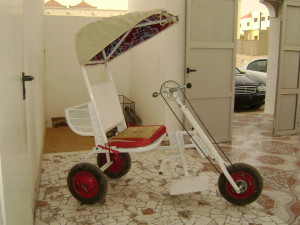
While initial testing seemed to prove the strength of the basic frame concept, our PT saw in it the opportunity to add an adjustable seat back as well as an adjustable leg support system. Fortunately, due to the nature of the design, all this could be done with few additional parts.
Future DOTTs would now be fully adjustable to the user in all critical dimensions. It was also on the DOTT-B that we began to use shorter crank arms and better gear ratios after further research by our PT.
By this time we felt that we were ready to make a limited production run and send as many as we could overseas to see how they performed. Many of these trikes went to places in Africa, South America, the Caribbean and Eastern Europe. About 35 were made in North Africa, some from kits and some from mostly local materials. Back in the US, a few were used as trial horses to experiment with different wheel and tire types, as well as faster gear ratios for smooth roads and long distances.
These trikes were often donated with the only request being that the user(s) would report back to us with as much detail as possible about how they performed. While we did have one frame failure (that would result in the inclusion of what we nick-named the “Haiti brace” in all future production), by and large the trikes performed well.
———————————————————————-
2008-2012
DOTT-B IMPROVEMENTS
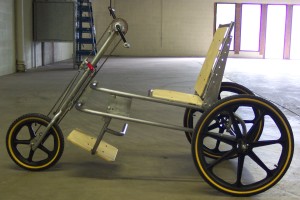 While the first DOTTs were being designed, we were also thinking about how to create fixturing for the frame so that welding and assembly would be easier to perform. (see picture?) During this time we had such fixturing made for us and found that production time could be reduced to a third of what it normally took to build such a trike.
While the first DOTTs were being designed, we were also thinking about how to create fixturing for the frame so that welding and assembly would be easier to perform. (see picture?) During this time we had such fixturing made for us and found that production time could be reduced to a third of what it normally took to build such a trike.
The DOTT-B would see many more improvements as feedback came in from around the globe. In fact, one of our best suggestions came from a guy who worked for one of our financial supporters in Texas. His suggestion would allow us to make all rear axles removable for shipping, and adjustable (in width) in the field for local conditions.
Other requests from places like Sierra Leone (2012) would spur us to design a retractable downhill tiller/brake system. This option allowed the user to both brake and steer the trike without the need to try and control the trike on steep downhills using the pedals,a boon to those with weak arms or heavy loads. (In Sierra Leone, they also felt that the standard trike size was a little larger than what they really needed, an issue we would revisit later).
A suggestion from a yachtsman in Chicago would lead to a durable and relatively cheap source of plastic for our seat surfaces, thus eliminating wood rot issues in wet climes.
So many improvements were accumulating that we were drawing up plans to incorporate them all into a new design to be called the DOTT-C. However, experiments with a child-sized version of the DOTT were about to change all that.
———————————————————————-
2011
THE GENESIS OF THE DOTT-CC
About this time we were contacted by a person in South America about the possibility of a smaller version of the DOTT being made for a child. We eventually decided to make a prototype of such a trike by taking the basic DOTT-B and reducing the wheelbase, seat height and other dimensions as required (2011).
Surprisingly, this new “compact” design still fit most women and men up to about 5′ 6″ comfortably. It also reduced weight, improved maneuverability and would be easier to ship. We designated this new design the DOTT-CC because it had all the improvements of the previous DOTT-C “paper” design, but was of a “compact” size.
This would now become the standard trike for overseas deployment. While we were generally pleased with the positive responses we were receiving on the basic design, we knew that there were still going to be endless opportunities for improvement.
By this time the entire design (including complete drawings) was already being made avaliable at no charge to anyone working to help the disabled. We already knew that some of the best suggestions for improvements had come from others outside the organization. We also knew that we were a small organization with very limited resources. Finally, we came to realize…with our many University contacts…that college students and their professors might relish the opportunity to provide their energy and ideas to help move hand pedaled trike design forward.
———————————————————————-
2011-PRESENT
THE DOTT-CC AND THE “UNIVERSITY CONSORTIUM”
Over the years our founder, Alice Teisan, had established many contacts with various other organizations, including many colleges and universities. As it turned out, many universities had dabbled in design for the disabled, often times attempting to design things like hand pedaled trikes. Usually this took the form of a few students from a class teaming up to try and solve a specific problem (or, with the limited time available, just get as far as they could before the semester ended). It was, of course, a great idea to involve students in such projects. After all, who has more energy and more ideas than a group of college students. But, this practice always came with a serious down side. Students, by the very nature of the education system, had a very limited amount of time to devote to problems that could take years to adequately define, test and resolve. Much of their time was lost just trying to find a “worthy cause” or project to work on…and then they had to define the exact nature of the problem, understand the possible paths to a solution, figure out where to access the raw materials and knowledge needed…all before they could even get started solving the actual problem. To make things worse, other unrelated classes were demanding their attention also. Almost before they could really get to the point of understanding the nature problem, they had to attempt to solve it, write a paper and move on to the next class or graduate.
At HWI we realized that we had a very different problem. Years of research had taught us much about the many compromises and problems faced in hand pedaled trike design. Some of these we had been able to solve… or at least improve upon. We could certainly define the areas that still needed research and better solutions. We also knew where to find the materials and other resources that would be required along the way. But we now realized that no one person, or even a small organization would ever have enough time or energy to pursue and solve every issue out there. The thought occurred to us that it might be time to start working with like-minded people at colleges, universities and other trike organizations to pool our resources. Maybe we could all work together to improve hand pedaled trike design. We could help students by defining the problems and opportunities. We could even provide some resources and expertise. They could then focus their energy and creativity on ways to solve the actual problem without the usual delays.
To learn more about our University Consortium
(need some US Trike pictures here, and a few of the variable position crank)
———————————————————————-
RELATED PROJECTS AND RESEARCH THAT HAVE CONTRIBUTED IN SOME WAY TO OUR TRIKE DESIGNS
———————————————————————-
A spin-off of the early Lowrider hand pedaled trike project was the Sirocco hand-pedaled, delta configuration “junior racing” style trike. This design came about as a result of our meeting a very young disabled girl at a Joni And Friends retreat in Indiana. We had taken several trike designs there for testing by the people there, but this girl seemed to be spending every waking moment using the Lowrider. We eventually agreed to make a copy of the trike for her, but more suited to her size.
Shortly after accepting the project, we began to lay out the design in AutoCad (as we do with all our designs). As work progressed, it became a bit more refined and sophisticated than the original concept. We learned that commercially avaliable hand pedaled “racing style” trikes for young people can be notoriously difficult to get in and out of. Eventually, with the help of our Physical Therapist, we decided to use this project to experiment with improving entry/exit issues in such a design. We also wanted to position the feet securely a safe distance from the front wheel spokes (another common problem in the market) as well as improve the steering radius (also a common issue). Finally, we wanted it to look good and be as light as possible, with an easy to master gear system for a young person. Because of all the new ideas and a somewhat unique layout, we decided to make an experimental prototype first…and let her try it out for a while before we made her trike. (This would become the “red” Sirocco). After trying the trike out, she pronounced it a success. But she still had one more request. She wanted her’s to be pink with white “flames”. A year later, it was delivered…in pink with white flames.
———————————————————————-
2007
———————————————————————-
THE TOMAHAWK PROTOTYPE
Another spin-off of the early Lowrider hand pedaled trike project was the Tomahawk foot pedaled, delta configuration trike. This design came about as a result of the continuing positive feedback we had received from non-handicapped people who tried the Lowrider. They liked the low and fast “go-cart” feel of the trike, as well as the speed of the higher gearing. They envisioned how a lighter, faster foot-powered design of similar configuration with better seating might feel (and so did we). Thus was born the Tomahawk concept.
Starting with a specially made carbon fiber reinforced seat placed just inches off the ground, we designed a 7-speed geartrain to run below it on a “T” shaped chrome moly frame. Steering geometry did take a few tries to work out, but with relatively large diameter 24″ wheels in the back (on custom made wide hubs) and a 16″ wheel in the nose way out front, the ride felt smooth and fast. With the ultra-low center of gravity, high speed turns were no problem (although they did require the re-design of the seat for much better lateral support). On some smooth surfaces a power-slide was even possible.
While meant primarily for fun, much was learned from the research and development involved in this complex design. Perhaps the greatest contribution was in the knowledge we gained about the use of large diameter spoked wheels in high lateral stress situations, a condition often seen and inadequately planned for in some hand pedaled trike designs. In fact, that knowledge would be an important contribution to the later US Trike design concept.




